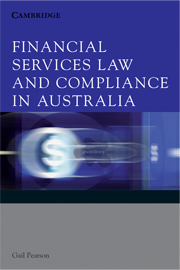Book contents
- Frontmatter
- Contents
- Preface
- List of Abbreviations
- Table of Statutes
- Table of Cases
- 1 The financial citizen and the market
- 2 The regulatory structure
- 3 An overview of financial services reform
- 4 Licensing financial services providers
- 5 The role of disclosure in the distribution of financial products
- 6 Selling financial products and other conduct
- 7 Deposit-taking and payments
- 8 Investment
- 9 Insurance
- 10 Consumer credit
- 11 Superannuation
- 12 Compliance, enforcement and remedies
- Index
- References
9 - Insurance
Published online by Cambridge University Press: 05 June 2012
- Frontmatter
- Contents
- Preface
- List of Abbreviations
- Table of Statutes
- Table of Cases
- 1 The financial citizen and the market
- 2 The regulatory structure
- 3 An overview of financial services reform
- 4 Licensing financial services providers
- 5 The role of disclosure in the distribution of financial products
- 6 Selling financial products and other conduct
- 7 Deposit-taking and payments
- 8 Investment
- 9 Insurance
- 10 Consumer credit
- 11 Superannuation
- 12 Compliance, enforcement and remedies
- Index
- References
Summary
[T]he most significant item in the accounts of a general insurer is its provision for outstanding claims.1
What is insurance and what does it do?
Consumers enter into contracts of insurance to manage the risk that their house, car, household goods or even their health could be damaged or destroyed. Indeed, insurance allows consumers to protect themselves against many of the risks inherent in their daily lives. Consumers expect that when events occur that require them to claim on their insurance policies they will be able to do so expeditiously. In recent times, however, this has not always been the case. As with investment schemes, insurance companies have failed, leaving people not only unable to claim on their policies, but unable to obtain insurance at all. Even without market failure, it is possible that in some circumstances claims will be denied as consumers have not understood the extent of cover they have contracted for or their obligations under the contract. This chapter provides an overview of the Australian insurance industry and its regulation, looking at insurance-specific legislation and codes of practice. The recent insurance crisis is also analysed to the extent that it illustrates overall regulatory issues.
Insurance is concerned with shifting and spreading the risk of loss. Indeed, it could be said that ‘[t]he aim of insurance is to shift the risk from one person (the insured) to another (the insurers)’. Insurers are commonly insurance companies or firms of underwriters.
- Type
- Chapter
- Information
- Financial Services Law and Compliance in Australia , pp. 352 - 400Publisher: Cambridge University PressPrint publication year: 2009



